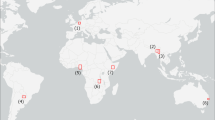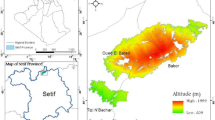Abstract
Satellite precipitation data is an indirect measurement for land and water area over the globe. The information from this data is important especially to the area where direct rain gauge measurement is limited. However, the precipitation estimates require calibration and validation to assure the accuracy. Satellite rainfall estimations together with comprehensive ground validation and calibration have been found to offer good prospect for accurate and global rainfall database especially for remote areas and large bodies of water. This work presents performance evaluation of TRMM 3B43 V7 rainfall retrieval algorithms over Malaysia. Inter-comparison and validation of TRMM 3B43 V7 rainfall product with ground measurement is analysed statistically. The result of continuous statistical evaluation shows good agreement, in which, the best correlation for the algorithm 3B43 versus rain gauge is 0.9384. At lower percentage bias threshold, the 2 by 2 categorical statistic of rain or no rain occurrence for annual estimation reveals lower value of probability of detection and higher value of false alarm ratio. However, reverse results are shown at higher bias threshold. The accuracy of the algorithm for a threshold of 1–10 % which falls within International Telecommunication Union—Radio recommendation for radio propagation to discriminate between rain and no rain is 0.53, 0.49 and 0.48 for annual, monthly and wet season, respectively. From analysis, the categorical statistical approach has been able to reveal the level of accuracy of the algorithms as applicable to detection and estimation of rainfall.





Similar content being viewed by others
References
P.A. Arkin, P. Xie, The global precipitation climatology project: first algorithm intercomparison project, Bulletin of the American Meteorological Society, 75(3) (1994) 401–420.
F.A. Semire, R. Mohd-Mokhtar, W. Ismail, et al., Satellite and ground data rainfall characterization in Malaysia, Proceedings of IEEE international conference on space science and communication (IconSpace2011), Penang, Malaysia, (2011) pp 77–82.
I. Koumare, Temporal/spatial distribution of rainfall and the associated circulation anomalies over West Africa, Pakistan J. of Meteorology, 10(20) (2014) 1–11.
T. Xu, B. Croke, M.F. Hutchinson, Identification of spatial and temporal patterns of Australian daily rainfall under a changing climate, 7th international congress on environmental modelling and software, (2014) pp 1–8.
M.C. Todd, J.O. Bailey, Estimates of rainfall over the UK and surrounding seas from SSM/I using polarized corrected temperature algorithm, J. of Applied Meteorology, 34(6) (1995) 1254–1266.
E.E. Ebert, M.J. Manton, Performance of satellite rainfall estimation algorithms during TOGA COARE, J. of Atmospheric Sciences, 55(9) (1998) 1537–1557.
E.E. Ebert, Methods for verifying satellite precipitation estimates, Measuring precipitation from space: EURAINSAT and the future, advances in global change research, 28, (2007) pp. 345–356.
P. Xie, P.A. Arkin, Analyses of global monthly precipitation using gauge observations, satellite estimates, and model predictions, J. of Climate, 9(4) (1996) 840–858.
P. Xie, P.A. Arkin, Global precipitation: a 17-year monthly analysis based on gauge observations, satellite estimates, and numerical model outputs, Bulletin of the American Meteorological Society, 78 (1997) 2539–2558.
R.F. Adler, C. Kidd, G. Petty, et al., Inter comparison of global precipitation products, Third precipitation intercomparison project (PIP -3), Bulletin of the American Meteorological Society, 82(7) (2001) 1377–1396.
R.F. Adler, G.J. Huffman, P.R. Keehn, Global tropical rain rate estimates from microwave-adjusted geosynchronous IR data, Remote Sensing Reviews, 11 (1994) 125–152.
R.R. Ferraro, G.F. Marks, The development of SSM/I rain-rate retrieval algorithms using ground-based radar measurements, J. of Atmospheric & Oceanic Technology, 12(4) (1995) 755–770.
D. Tsintikidis, J.L. Haferman, E.N. Anagnostou, et al. A neural network approach to estimating rainfall from spaceborne microwave data, IEEE Trans. on Geoscience & Remote Sensing, 35(5) (1997) 1079–1093.
K.L. Hsu, H.V. Gupta, X. Gao, et al., Estimation of physical variables from multichannel remotely sensed imagery using a neural network: application to rainfall estimation, Water Resources Research, 35(5) (1999) 1605–1618.
G.W. Petty, W.F. Krajewski, Satellite estimation of precipitation over land, Hydrological Sciences Journal, 41(4) (1999) 433–451.
M.D. Conner, G.W. Petty, Validation and intercomparison of SSM/I rain-rate retrieval methods over the continental United States, J. of Applied Meteorology, 37 (1998) 679–700.
M. Grecu, E.N. Anagnostou, Overland precipitation estimation from TRMM passive microwave observations, J. of Applied Meteorology, 40 (2001) 1367–1380.
C.D. Kummerow, W. Barnes, T. Kozu, et al., The tropical rainfall measuring system (TRMM) sensor package, J. of Atmospheric & Oceanic Technology, 15 (1998) 809–817.
Y. Ji, Validation of diurnal cycle and intra-seasonal variability of TRMM satellite rainfall, PIERS Online, 2(6) (2006) 628–632.
S. Wagner, H. Kunstmann, A. Bardossy, et al., Water balance estimation of a poorly gauged catchment in West Africa using dynamically downscaled meteorological fields and remote sensing information, Physics & Chemistry of the Earth, 34 (2008): 225–235.
V.T. Omotosho, C.O. Oluwafemi, Impairment of radio wave signal by rainfall on fixed satellite service on earth-space path at 37 stations in Nigeria, J. of Atmospheric & Solar-Terrestrial Physics, (2009), 830–840.
J. Wang, D.B. Wolff, Evaluation of TRMM ground – validation radar- rain errors using rain gauge measurements, J. of Applied Meteorology and Climatology, 49 (2010), 310–324.
F.A. Semire, R. Mohd-Mokhtar, W. Ismail et al., Ground validation of space-borne satellite rainfall products in Malaysia, J. of Advances in Space Research, 50 (2012) 1241–1249.
S. Sooroshian, K. Hsu, X. Gao, et al., Evaluation of PERSIANN system satellite-based estimate of tropical rainfall, Bulletin of the American Meteorological Society, 81 (2005) 2035–2046.
M. Kastner, F. Torricella, S. Davolio, Intercomparison of satellite-based and model-based rainfall analyses, Meteorological Applications, 13(3) (2006) 213–223.
B.J. Sohn, H.-J. Han, E.-K. Seo, Validation of satellite-based high-resolution rainfall products over the Korean Peninsula using data from a dense rain gauge network, J. of Applied Meteorology & Climatology, 49(4) (2010) 701–714.
Malaysia Meteorological Department. Climate change scenarios for Malaysia 2001-2099, Scientific Report, Numerical Weather Prediction Development Section, 2009, Malaysia Meteorological Department, Petaling Jaya, Malaysia.
A. Yagasena, S.I.S. Hassan, M.M.M. Yusoff, Rain attenuation prediction at 6.75 GHz in Malaysia using rain gauge and radiometer measurements, Proceedings of IEEE international conference on information engineering, 3–7 Jul, Singapore (1995), pp 596–599.
J.S. Mandeep, Rain rate analysis and total rain accumulation in the North of Malaysia Peninsular, Annals of Telecommunications, 66 (2011) 377–381.
R.S.V. Teegavarpu, V. Chandramouli, Improved weighting methods, deterministic and stochastic data-driven models for estimation of missing precipitation records. J. of Hydrology, 312 (2005) 191–206.
‘NASA-GSFC. National Aeronautics and Space Administration, Goddard Space Flight Centre’, http://www.gsfc.nasa.gov/, accessed Sept. 2011.
G.J. Huffman, R.F. Adler, B. Rudolf, et al., Global precipitation estimates based on a technique for combining satellite-estimates, rain gauge analysis, and NWP model precipitation estimation, J. of Climate, 8 (1995) 1284–1295.
G.J. Huffman, D.T. Bolvin, TRMM and other data precipitation data set documentation, laboratory for atmospheres, NASA Goddard Space Flight Centre and Science Systems and Applications, Inc., 2008, Available at: http://disc.sci.gsfc.nasa.gov.
A.H. Murphy, What is a good forecast? An essay on the nature of goodness in weather forecasting, Weather Forecasting, 8 (1993) 281–293.
A.H. Murphy, The coefficients of correlation and determination as measures of performance in forecast verification, Weather Forecasting, 10 (1995) 681–688.
M.L.M. Scheel, M. Rohrer, C. Huggel, et al., Evaluation of TRMM multi-satellite precipitation analysis (TMPA) performance in the Central Andes region and its dependency on spatial and temporal resolution. Hydrology & Earth System Sciences, 15 (2011) 2649–2663.
ITU-R P.618. Propagation data and prediction methods required for the design of earth-space, Telecommunication System, Geneva (2008).
S. Armstrong, Long-rang forecasting: from crystal ball to computer, Wiley, New York (1995).
B.E. Flores, A pragmatic view of accuracy measurement in forecasting. Omega, 14(2) (1986) 93–98.
D.S. Wilks, Statistical methods in the atmospheric sciences, 3rd ed., Academic Press, Oxford, UK, (1995).
E.E. Ebert, J.L. McBride, Verification of precipitation in weather systems: determination of systematic errors, J. of Hydrology, 239(1–4) (2000) 179–202.
M.L. Nirala, A.P. Cracknell, The determination of the three-dimensional distribution of rain from the tropical rainfall measurement mission (TRMM) precipitation Radar, Int. J. of Remote Sensing, 23(20) (2002), 4263–4304.
J. Gottschalck, J. Meng, M. Rodell, et al., Analysis of multiple precipitation products and preliminary assessment of their impact on global land data assimilation system land surface states, J. of Hydrometeorology, 6(5) (2005) 573–598.
F. Su, Y. Hong, D.P. Lettenmaier, Evaluation of TRMM multisatellite precipitation analysis (TMPA) and its utility in hydrologic prediction in the La Plata Basin, J. of Hydrometeorology, 9(4) (2008): 622–640.
D.A. Vila, L.G.G. De-Goncalves, D.L. Toll, et al., Statistical evaluation of combined daily gauge observations and rainfall satellite estimates over Continental South America, J. of Hydrometeorology, 10 (2009) 533–543.
Acknowledgments
The authors would like to appreciate the support of National Aeronautics and Space Administration (NASA) USA and National Space Development Agency (NASDA) Japan for free access to their rainfall data archive. Many thanks go to Malaysia Meteorological Department (MMD) and Department of Irrigation and Drainage Malaysia (DIDM), for making their precipitation data available to us.
Author information
Authors and Affiliations
Corresponding author
Rights and permissions
About this article
Cite this article
Semire, F.A., Mohd-Mokhtar, R. Evaluation of Satellite Retrieval Algorithm to Ground Rainfall Estimates Over Malaysia. MAPAN 31, 177–187 (2016). https://doi.org/10.1007/s12647-016-0171-7
Received:
Accepted:
Published:
Issue Date:
DOI: https://doi.org/10.1007/s12647-016-0171-7




